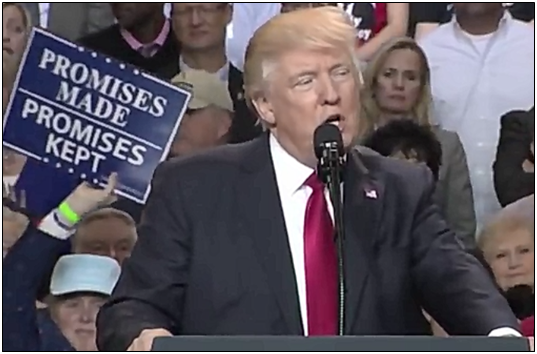The Republican strategy on tax and health care reform was built on a house of cards that has now collapsed.
The problem was not Republican moderates or the conservative House Freedom Caucus per se — there did not appear to be the votes in the Senate either for the Obamacare makeover proposed by House Speaker Paul Ryan.
Instead the greatest obstacle the GOP and President Donald Trump face remains byzantine Senate rules on the filibuster, which require 60 votes to overcome, and on rules on budget reconciliation, with bills only requiring 51 votes to pass but with severe restrictions on what members perceive can be included.
Having failed to secure the votes needed to get the health care overhaul through the House, Republicans are now setting their sights on tax reform.
But as reported by the New York Times’ Alan Rappeport, what may be achieved on taxes under reconciliation may not be as expansive as previously intended.
Rappeport notes, “To make their changes to the tax code permanent, their plans cannot add to deficits over a period of 10 years. Eliminating the $1 trillion of Affordable Care Act taxes and the federal spending associated with that law would have made this easier. Because they failed, Republicans will struggle to reach their goal of cutting corporate tax rates without piling on debt.”
Reading between the lines, that means the health care overhaul was always a part of the tax package, designed to achieve more favorable budget scores for the tax bill when it came up next year on reconciliation.
Surely members were briefed by Republican leaders on this feature and threatened that rejecting the health care proposal would jeopardize tax reform.
But why were such choices even necessary?
Consider, repealing and replacing Obamacare was constrained by what could be considered a budgetary measure under reconciliation — which Republican leaders argued could not include the insurance regulations under the health care law — plus the deficit-neutral rules, and had to fit into the pre-determined framework of getting next year’s tax bill a better budget score.
It is little wonder then that the health care legislation underwhelmed in so many key areas, including its failure to create a national market for insurance by allowing purchases across state lines. It explains to a T why the health care bill was designed the way it was, and why it failed to garner majority support in the House.
And it tells the American people exactly what is necessary in order to get real health care and tax reforms from a free market perspective — or much of anything else done.
We don’t need conservatives in Congress to bow to whatever mutant legislation might be crafted under reconciliation rules, or for Republican leaders to work with Senate Democrats to produce bills that can overcome the filibuster — instead, Senate rules should just be changed.
It has been 100 years since the advent of Rule XXII of the Senate’s standing rules in 1917. In that time, Republicans have never had a filibuster-proof majority in the U.S. Senate, and if history holds, they never will.
This undemocratic feature of Senate rules means that even when Republicans win elections, as in 2016, they cannot ever pass their ideal legislation, disenfranchising voters year after year who demanded a more market-oriented approach to the hard issues facing the nation.
So perhaps it’s time to go nuclear and kill the filibuster once and for all.
Besides, Senate supermajorities have been the exclusive province of Democrats. The New Deal, Great Society, and the first two years of the Obama administration that brought the health care law, the so-called “stimulus,” and Dodd-Frank were all enacted after Democrats had won the White House, House, and a filibuster-proof majority in the Senate.
The Social Security Act was in enacted in 1935, right after Democrats had won 69 Senate seats — back then that was out of 96 possible seats, making a 72 percent majority, more than enough to reach a two-thirds vote then needed for cloture. The Democrats’ filibuster-proof Senate majority would last through 1942.
The National Labor Relations Act, establishing the National Labor Relations Board, was enacted in 1935.
The Medicare Act of 1965 passed after the 1964 election awarded Democrats with 68 Senate seats, plus the White House and House. This filibuster-proof majority would last only two years, however.
But, by 1975, Democrats again reclaimed such a majority, simply by changing the rules, from a two-thirds majority to a three-fifths majority to invoke cloture. And they held it in 1976, paving the way for Jimmy Carter to govern with a filibuster-proof majority. That yielded the Humphrey-Hawkins Full Employment Act of 1978, which, among other things, gave us the Federal Reserve’s dual mandate.
That would be the last filibuster-proof majority until 2008, when Democrats regained it after Republicans were wiped out amid the financial crisis. And not to mention Sen. Arlen Specter, who switched parties to get the Democrats to 60 votes through 2010. That yielded Dodd-Frank and Obamacare.
Republicans, conversely, have had to rely on government shutdowns, debt ceiling showdowns and budget reconciliation to get much of anything done legislatively, whether on taxes, defense spending or the like in the 1980s and the 2000s. Otherwise, legislation relied on Democrat participation.
In other words, almost every major legislative change, particularly on entitlements, in the past century has been with Democrats in the driver’s seat. When, exactly, will Republicans ever get an opportunity, under Senate rules, to even attempt an alternative?
The answer is never, unless those Senate rules are changed — right now. Republicans have an opportunity to govern now, not via budget reconciliation maneuvers, but by putting their best legislation forward, and passing it with a simple majority. If that means killing the filibuster once and for all, so be it.
Senate rules including the filibuster and budget reconciliation are not stopping big spending programs and the administrative state from taking root, it’s locking them in — and guaranteeing we will never get rid of them.
Robert Romano is the senior editor of Americans for Limited Government.







